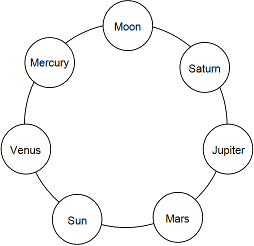The Week

- What is the origin of the 7-day week?
- What do the names of the days of the week mean?
- What is the system behind the planetary day names?
- Has the 7-day week cycle ever been interrupted?
- Which day is the day of rest?
- What is the first day of the week?
- What is the week number?
- How can I calculate the week number?
- Do weeks of different lengths exist?
The Christian, the Hebrew, the Islamic, and the Persian calendars all have a 7-day week.
What is the origin of the 7-day week?
Digging into the history of the 7-day week is a very complicated matter. Authorities have very different opinions about the history of the week, and they frequently present their speculations as if they were indisputable facts. In short, nothing can be said with certainty about the origin of the 7-day week.
The first pages of the Bible explain how God created the world in six days and rested on the seventh. This seventh day became the Jewish day of rest, the Sabbath, Saturday.
Extra-biblical locations sometimes mentioned as the birthplace of the 7-day week include: Babylon, Persia, and several others. The week was known in Rome before the advent of Christianity.
What do the names of the days of the week mean?
An answer to this question is necessarily closely linked to the language in question. Whereas most languages use the same names for the months (with a few Slavonic languages as notable exceptions), there is great variety in names that various languages use for the days of the week. A few examples will be given here.
Except for the Sabbath, Jews simply number their week days.
A related method is partially used in Portuguese and Russian:
| English | Portuguese | Russian | Meaning of Russian name |
|---|---|---|---|
| Monday | segunda-feira | понедельник (ponedelnik) | After “do-nothing” |
| Tuesday | terça-feira | вторник (vtornik) | Second |
| Wednesday | quarta-feira | среда (sreda) | Middle |
| Thursday | quinta-feira | четверг (chetverg) | Fourth |
| Friday | sexta-feira | пятница (pyatnitsa) | Fifth |
| Saturday | sabado | суббота (subbota) | Sabbath |
| Sunday | domingo | воскресенье (voskresenye) | Resurrection |
Note the difference in numbering in these two languages: In Portuguese Wednesday is called “the fourth day”, quarta-feira; but in Russian Thursday is called “the fourth day”, chetverg.
Most Latin-based languages connect each day of the week with one of the seven “planets” of the ancient times: Sun, Moon, Mercury, Venus, Mars, Jupiter, and Saturn. French, for example, uses:
| English | French | “Planet” |
|---|---|---|
| Monday | lundi | Moon |
| Tuesday | mardi | Mars |
| Wednesday | mercredi | Mercury |
| Thursday | jeudi | Jupiter |
| Friday | vendredi | Venus |
| Saturday | samedi | Saturn |
| Sunday | dimanche | (Sun) |
The link with the sun has been broken in French, but Sunday was called dies solis (day of the sun) in Latin.
It is interesting to note that also some Asiatic languages (for example, Hindi, Japanese, and Korean) have a similar relationship between the week days and the planets.
English has retained the original planets in the names for Saturday, Sunday, and Monday. For the four other days, however, the names of Anglo-Saxon or Nordic gods have replaced the Roman gods that gave name to the planets. Thus, Tuesday is named after Tiw, Wednesday is named after Woden, Thursday is named after Thor, and Friday is named after Frigg.
What is the system behind the planetary day names?
As we saw in the previous section, the planets have given the week days their names following this order:
Moon, Mars, Mercury, Jupiter, Venus, Saturn, Sun.
Why this particular order?

One theory goes as follows: Assuming the Earth to be the center of the universe, order the “planets” according to their period of revolution around the Earth, you arrive at this order:
Moon, Mercury, Venus, Sun, Mars, Jupiter, Saturn.
Arrange this sequence of planets anticlockwise on a circle, as in the illustration to the right. Now, starting with the Moon (Monday) count the 24 hours of the day clockwise around the circle: 1-Saturn, 2-Jupiter, 3-Mars, 4-Sun, etc. until you reach 24-Mars. Mars (Tuesday) is now the next starting point. Once again, count clockwise around the circle: 1-Sun, 2-Venus, 3-Mercury, etc. until you reach 24-Mercury. Mercury (Wednesday) is now the next starting point. If you continue is this way, each time noting the 24th planet, you will visit the planets in this order: The Moon (Monday), Mars (Tuesday), Mercury (Wednesday), Jupiter (Thursday), Venus (Friday), Saturn (Saturday), the Sun (Sunday), after which you return to the Moon (Monday).
In other words, you visit the planets in exactly the order of the associated week days. Coincidence? Maybe.
Has the 7-day week cycle ever been interrupted?
There is no record of the 7-day week cycle ever having been broken. Calendar changes and reform have never interrupted the 7-day cycles. It is very likely that the week cycles have run uninterrupted at least since the days of Moses (c. 1400 BC), possibly even longer.
Some sources claim that the ancient Jews used a calendar in which an extra Sabbath was occasionally introduced. But this is probably not true.
Which day is the day of rest?
For the Jews, the Sabbath (Saturday) is the day of rest and worship. On this day God rested after creating the world.
Most Christians have made Sunday their day of rest and worship, because Jesus rose from the dead on a Sunday.
Muslims use Friday as their day of rest and worship. According the Muslim Hadith writings, Friday is the king of all days because Adam was created and died on a Friday, and judgement day will be a Friday.[1]
What is the first day of the week?
The Bible clearly makes the Sabbath (corresponding to our Saturday) the last day of the week.[2] Therefore it is common Jewish and Christian practice to regard Sunday as the first day of the week (as is also evident from the Portuguese names for the week days). However, the fact that, for example, Russian uses the name “second” for Tuesday, indicates that some nations regard Monday as the first day.
In international standard ISO 8601 the International Organization for Standardization has decreed that Monday shall be the first day of the week.
The current week is:
What is the week number?
International standard ISO 8601 assigns a number to each week of the year. A week that lies partly in one year and partly in another is assigned a number in the year in which most of its days lie. This means that
Week 1 of any year is the week that contains the first Thursday in January.
or equivalently
Week 1 of any year is the week that contains 4 January,
Most years have 52 weeks, but all years that start on a Thursday and leap years that start on a Wednesday have 53 weeks.
Note: This week numbering system is not commonly used in the United States.
How can I calculate the week number?
If you know the date, you can calculate the corresponding week number (as defined in ISO 8601) as descibed below. (Click here for a description of the symbols and and the operator ‘mod’.)
| For dates in January and February, calculate: | ||||||||||||||||||||||||||||||||||||||||||||||
|
||||||||||||||||||||||||||||||||||||||||||||||
| For dates in March through December, calculate: | ||||||||||||||||||||||||||||||||||||||||||||||
|
||||||||||||||||||||||||||||||||||||||||||||||
| Then, for any month continue thus: | ||||||||||||||||||||||||||||||||||||||||||||||
|
||||||||||||||||||||||||||||||||||||||||||||||
| We now have three situations: | ||||||||||||||||||||||||||||||||||||||||||||||
|
This algorithm gives you a couple of additional useful values:
- d indicates the day of the week (0=Monday, 1=Tuesday, etc.)
- f + 1 is the ordinal number of the date within the current year.
Do weeks of different lengths exist?
If you define a “week” as a 7-day period, obviously the answer is no. But if you define a “week” as a named interval that is greater than a day and smaller than a month, the answer is yes.
The ancient Egyptians used a 10-day “week”, as did the French Revolutionary calendar.
The Maya calendar uses a 13 and a 20-day “week”.
The Soviet Union has used both a 5-day and a 6-day week. In 1929-30 the USSR gradually introduced a 5-day week. Every worker had one day off every week, but there was no fixed day of rest. On 1 September 1931 this was replaced by a 6-day week with a fixed day of rest, falling on the 6th, 12th, 18th, 24th, and 30th day of each month (1 March was used instead of the 30th day of February, and the last day of months with 31 days was considered an extra working day outside the normal 6-day week cycle). A return to the normal 7-day week was decreed on 26 June 1940.
In calendrical calculations, we frequently use an operation call integer division.
Ordinarily we would say that, for example, 14 divided by 5 is 2.8. But when we use integer division, we discard the decimal fraction and simply state that 14 divided by 5 is 2.
We indicate that we use integer division by enclosing the division between the symbols and , for example thus:
14/5 = 2
or thus:
| 14 | ||
| 5 |
When we perform integer division, the division leaves a remainder. In the case of 14 divided by 5, the remainder is 4: We can subtract 5 twice from 14, and this leaves us with 4.
We use the mathematical operator ‘mod’ to indicate the remainder. This is known as the modulo operator. We therefore have:
14 mod 5 = 4
If you want to use integer division in computer programs, you must realize that different programs use different notations for the operations. The following table shows how integer division and the modulo operator may be written:
| Integer division | Modulo | |
|---|---|---|
| The Calendar FAQ | 14/5 | 14 mod 5 |
| Microsoft Excel (English) | INT(14/5) | MOD(14,5) |
| Visual Basic | 14 \ 5 | 14 Mod 5 |
| C, C#, C++ | 14 / 5 | 14 % 5 |
NOTE: What is said here only applies to division of positive numbers. Different programming languages handle integer division of negative numbers differently; therefore the formulas in the Calendar FAQ avoid using these operations on negative numbers.
References
| ^ | [1] | http://library.faizaneattar.net/Books/Pages_en.php?id=314&img=4, retrieved 12 August 2011, quoting Sunan ibn-e-Majah, V2, P8, Hadith 1084, Dar-ul-Ma’rifa, Beirut. |
| ^ | [2] | For example, “After the Sabbath, at dawn on the first day of the week, Mary Magdalene and the other Mary went to look at the tomb.” (Matthew 28:1) |






